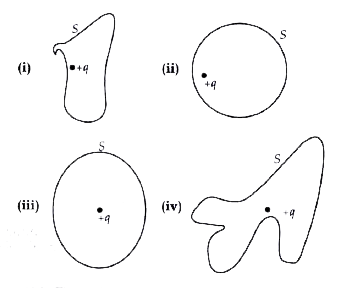A : If electric flux over a closed surface is negative then the surface encloses net negative charge.
R : Electric flux is independent of the charge distribution inside the surface.
If both Assertion & Reason are true and the reason is the correct explanation of the assertion, then mark (1).
If both Assertion & Reason are true but the reason is not the correct explanation of the assertion, then mark (2).
If Assertion is true statement but Reason is false, then mark (3).
If both Assertion and Reason are false statements, then mark (4).
The correct Answer is:B
To analyze the given statements regarding electric flux and charge enclosed within a closed surface, we will break down the problem step by step.
1. Understanding Electric Flux:
- Electric flux (ΦE) through a closed surface is defined by Gauss's law as:
ΦE=Qenclosedϵ0
- Where Qenclosed is the net charge enclosed by the surface and ϵ0 is the permittivity of free space.
2. Analyzing the Assertion (A):
- The assertion states: "If electric flux over a closed surface is negative, then the surface encloses net negative charge."
- From Gauss's law, if ΦE<0, it implies that:
Qenclosed<0
- Therefore, the assertion is correct because a negative electric flux indicates that the net charge enclosed is negative.
3. Analyzing the Reason (R):
- The reason states: "Electric flux is independent of the charge distribution inside the surface."
- This is true in the context that the total electric flux depends only on the total charge enclosed, not on how those charges are distributed within the surface.
- For example, if you have multiple charges inside the surface, moving them around (without changing the total charge) does not change the total flux through the surface.
4. Conclusion on the Statements:
- Both statements (A and R) are correct.
- However, the reason (R) does not explain the assertion (A). The assertion is specifically about the relationship between negative flux and negative charge, while the reason discusses the independence of flux from charge distribution.
5. Final Answer:
- Therefore, the correct conclusion is that:
- Statement A is correct.
- Statement R is correct.
- However, R is not the correct explanation for A.
- Electric flux (ΦE) through a closed surface is defined by Gauss's law as:
ΦE=Qenclosedϵ0
- Where Qenclosed is the net charge enclosed by the surface and ϵ0 is the permittivity of free space.
- The assertion states: "If electric flux over a closed surface is negative, then the surface encloses net negative charge."
- From Gauss's law, if ΦE<0, it implies that:
Qenclosed<0
- Therefore, the assertion is correct because a negative electric flux indicates that the net charge enclosed is negative.
- The reason states: "Electric flux is independent of the charge distribution inside the surface."
- This is true in the context that the total electric flux depends only on the total charge enclosed, not on how those charges are distributed within the surface.
- For example, if you have multiple charges inside the surface, moving them around (without changing the total charge) does not change the total flux through the surface.
- Both statements (A and R) are correct.
- However, the reason (R) does not explain the assertion (A). The assertion is specifically about the relationship between negative flux and negative charge, while the reason discusses the independence of flux from charge distribution.
- Therefore, the correct conclusion is that:
- Statement A is correct.
- Statement R is correct.
- However, R is not the correct explanation for A.
Similar Questions
Knowledge Check
Electric flux over a surface in an electric field
ApositiveBnegativeCzeroDpositive and negative ,zeroIf the net electric flux through a closed surface is zero, then we can infer
Ano net charge is enclosed by the surfaceBuniform electric field exists within the surfaceCelectric potential varies from point to point inside the surfaceDcharge is present inside the surfaceSTATEMENT -1 : If ∮→E.¯¯¯¯ds over a closed surface is negative,it means the surface encloses a net negative charge.
STATEMENT-2 : We may have a Gaussian surface in which three lines enter and five field lines are coming out.
STATEMENT-3 : The quantity ∮→E.¯¯¯¯ds is independent of the charge distribution inside the surface.AT T TBF F TCF T FDT F F
Electric flux through a closed surface in free space enclosing a charge q is
View SolutionContinuous charge distribution & Electric Flux
View SolutionElectric Flux And Equipotential Surface
View SolutionThe flux of electric field due to these charges through the surface S is

View SolutionA charge q is enclosed as shown below the electric flux is

View Solution

